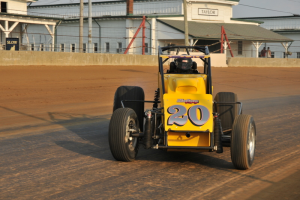
The Horses Beat the Cars

In our recent story about indoor auto racing in Syracuse, New York [Honey, I Shrunk the Race Track], we noted how few one-mile dirt tracks remain in operation, when decades ago such tracks were part of the same National Championship as the Indianapolis 500. This May, one of the three remaining dirt miles that still plays host to auto racing will bite the dust. (Yes, we went with the dirt pun. Sorry.)
The Indiana State Fair Commission announced in early April that the Indiana State Fairgrounds will discontinue auto racing at its one-mile oval after one final race, the 2019 Hoosier Hundred. This leaves only two, the DuQuoin State Fairgrounds in Illinois and the Illinois State Fairgrounds in Springfield, as fairgrounds miles that continue to present auto racing.
The United States Auto Club’s Hoosier Hundred at the fairgrounds dates back to 1953, although the track itself was built in 1892, when the Indiana State Fair established its permanent fairgrounds in Indianapolis – nearly 20 years before the Indianapolis Motor Speedway was built. Like virtually all fairgrounds ovals, the Indiana State Fairgrounds track was initially used as for horse racing. Automobiles, after all, were in their infancy, but it wasn’t long until fairgrounds ovals nationwide became staging grounds for motorized competition.
In one sense, though, the announcement shows the track’s use coming full circle. It is not development pressure that is ending auto racing at the Indiana State Fairgrounds, it’s horse racing. The plan is to cover the dirt oval track with crushed limestone to create an all-weather surface for harness racing, and to utilize the infield (where harness racing currently takes place on a smaller oval) as all-weather parking for the annual fair.
The United States Auto Club (USAC) issued a statement that indicated that discussions had taken place for some time to try to keep auto racing at the fairgrounds. That statement went on to say that, “The economics of the horse industry and their desire to use the one-mile track year-round instead of the half-mile currently in the infield won out in the end.”
The Indiana State Fairgrounds is often referred to as a historic place, and correctly so. Drivers the likes of A.J. Foyt, Al Unser, Parnelli Jones, and Mario Andretti all won there. One of racing’s original barnstormers, Barney Oldfield, became the first person to record an official average lap speed of 60 miles per hour or more – the original “mile-a-minute” – on the track in 1903.
And in a story comparable to that of Negro League baseball, a group of black Indianapolis businessmen formed the Colored Speedway Association and presented their first 100-mile race on the fairgrounds oval in 1924. The Colored Speedway Association went on to stage races at the fairgrounds and elsewhere into the late 1930s.
But all the racing history of the Indiana State Fairgrounds will soon be just that – history. The last Hoosier Hundred is set for May 23rd. And that, according to a statement released by the Indiana State Fair Commission, will be that. The statement read in part that the commission “recognize(s) the storied history that this track has played in auto racing, [but] is pleased that the track conversion will improve safety, enhance the guest experience and allow for the continuation of harness racing.”
Racing fans have launched a petition at Change.org, asking Indiana Governor Eric Holcomb to keep motorsports at the fairgrounds, but sadly, we expect that effort to be a DNF.
Photo courtesy United States Auto Club

